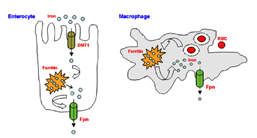Chédiak–Higashi syndrome is a rare autosomal recessive disorder that arises from a microtubule polymerization defect which leads to a decrease in phagocytosis. The decrease in phagocytosis results in recurrent pyogenic infections, partial albinism and peripheral neuropathy. It occurs in humans, cattle, white tigers, blue Persian cats, Australian blue rats, mice, mink, foxes, and the only known captive albino orca.
Signs and symptoms
 People with CHS have light skin and silvery hair, and frequently complain of solar sensitivity and photophobia. Other signs and symptoms vary considerably, but frequent infections and neuropathy are common. The infections involve mucous membranes, skin, and respiratory tract. Affected children are susceptible to gram-positive and gram-negative bacteria and fungi, with S. aureus being the most common. Neuropathy often begins in the teenage years and becomes the most prominent problem. Infections in CHS tend to be very serious and even life-threatening; few patients with this condition live to adulthood.
People with CHS have light skin and silvery hair, and frequently complain of solar sensitivity and photophobia. Other signs and symptoms vary considerably, but frequent infections and neuropathy are common. The infections involve mucous membranes, skin, and respiratory tract. Affected children are susceptible to gram-positive and gram-negative bacteria and fungi, with S. aureus being the most common. Neuropathy often begins in the teenage years and becomes the most prominent problem. Infections in CHS tend to be very serious and even life-threatening; few patients with this condition live to adulthood.
Most children with Chédiak–Higashi syndrome ultimately reach a stage known as the accelerated phase — the lymphoma-like-syndrome. This severe phase of the disease is thought to be triggered by a viral infection (usually the Epstein-Barr virus, EBV). In the accelerated phase, defective white blood cells divide uncontrollably and invade many of the body’s organs. The accelerated phase is associated with fever, episodes of abnormal bleeding, overwhelming infections, and organ failure. These medical problems are usually life-threatening in childhood.
Mutations have been found in the CHS1 (also called LYST) gene. The primary defect in this disease is in special granules present in skin pigment cells and certain white blood cells. For example, a granule that contains melanin is not made properly in skin, resulting in decreased skin pigmentation. A defect in granules found in certain types of white blood cells causes immune system problems. Albinism is typically partial, and some patients have peripheral neuropathy.
Causes
 Chédiak–Higashi syndrome is caused by mutations in the LYST gene. This gene provides instructions for making a protein known as the lysosomal trafficking regulator. Researchers believe that this protein plays a role in the transport (trafficking) of materials into structures called lysosomes. Lysosomes act as recycling centers within cells. They use digestive enzymes to break down toxic substances, digest bacteria that invade the cell, and recycle worn-out cell components. Although the lysosomal trafficking regulator protein is involved in the normal function of lysosomes, its exact role is unknown.
Chédiak–Higashi syndrome is caused by mutations in the LYST gene. This gene provides instructions for making a protein known as the lysosomal trafficking regulator. Researchers believe that this protein plays a role in the transport (trafficking) of materials into structures called lysosomes. Lysosomes act as recycling centers within cells. They use digestive enzymes to break down toxic substances, digest bacteria that invade the cell, and recycle worn-out cell components. Although the lysosomal trafficking regulator protein is involved in the normal function of lysosomes, its exact role is unknown.
Pathophysiology
It is a disease with impaired bacteriolysis due to failure of phagolysosome formation. As a result of disordered intracellular trafficking there is impaired lysosome degranulation with phagosomes, so phagocytosed bacteria are not destroyed by the lysosome’s enzymes.
In addition, secretion of lytic secretory granules by cytotoxic T cells is affected.
The disease is characterised by large lysosome vesicles in phagocytes (neutrophils), which thus have poor bactericidal function, leading to susceptibility to infections, abnormalities in nuclear structure of leukocytes, anemia, and hepatomegaly.
Diagnosis
The diagnosis is confirmed by bone marrow smears that show “giant inclusion bodies” in the cells that develop into white blood cells (leukocyte precursor cells). CHS can be diagnosed prenatally by examining a sample of hair from a fetal scalp biopsy or testing leukocytes from a fetal blood sample.
Under light microscopy the hairs present evenly distributed, regular melanin granules, larger than those found in normal hairs. Under polarized light microscopy these hairs exhibit a bright and polychromatic refringence pattern.
Clinical findings
There are several manifestations of Chédiak–Higashi syndrome as mentioned above; however, neutropenia seems to be the most common. The syndrome is associated with oculocutaneous albinism. Persons are prone for infections, especially with Staphylococcus aureus.
It is associated with periodontal disease of the deciduous dentition. Associated features include abnormalities in melanocytes (albinism), nerve defects, bleeding disorders.
Treatment
 There is no specific treatment for Chédiak–Higashi syndrome. Bone marrow transplants appear to have been successful in several patients. Infections are treated with antibiotics and abscesses are surgically drained when appropriate. Antiviral drugs such as acyclovir have been tried during the terminal phase of the disease. Cyclophosphamide and prednisone have been tried. Vitamin C therapy has improved immune function and clotting in some patients.
There is no specific treatment for Chédiak–Higashi syndrome. Bone marrow transplants appear to have been successful in several patients. Infections are treated with antibiotics and abscesses are surgically drained when appropriate. Antiviral drugs such as acyclovir have been tried during the terminal phase of the disease. Cyclophosphamide and prednisone have been tried. Vitamin C therapy has improved immune function and clotting in some patients.
Expectations (prognosis)
Death often occurs in the first 10 years of life, from chronic infections or accelerated disease that results in lymphoma-like illness. However, some affected children have survived longer.
Prevention
Genetic counseling is recommended before becoming pregnant if you have a family history of Chediak-Higashi.
Eponym
It is named for the Cuban physician and serologist Alejandro Moisés Chédiak (1903-1993) and the Japanese pediatrician Otokata Higashi (1902-1981). It is often spelled without the accent as Chediak–Higashi syndrome.